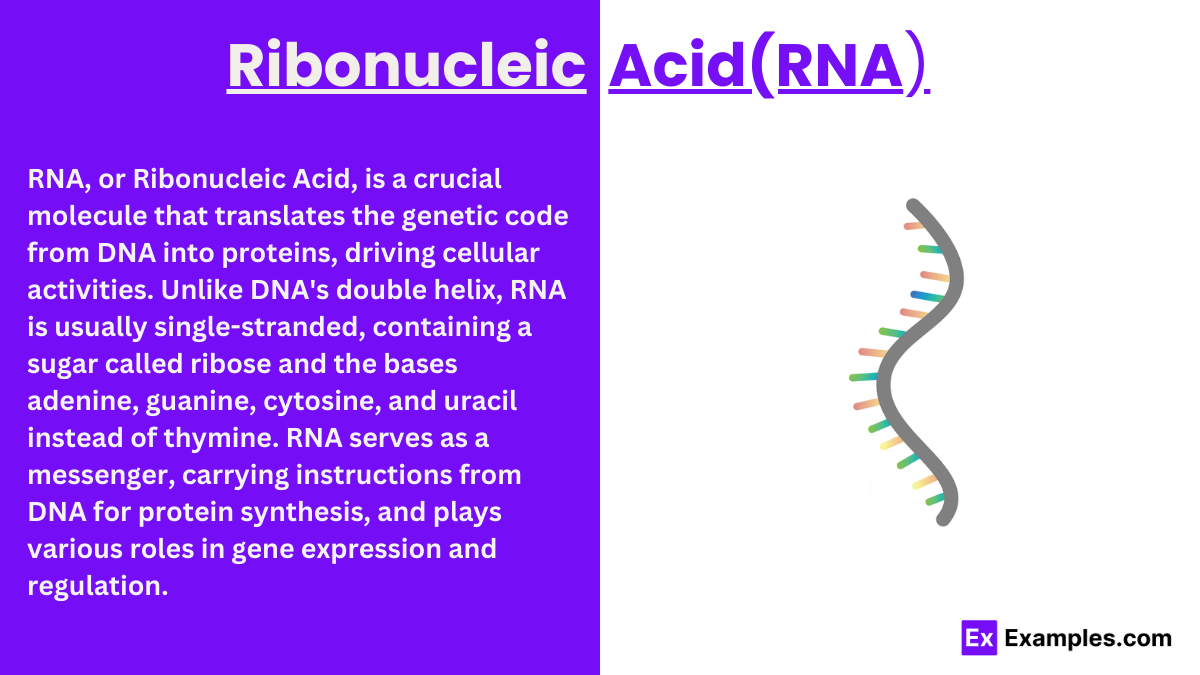Which of the following is a primary function of RNA?
Storing genetic information
Transmitting genetic information
Synthesizing proteins
Replicating DNA

RNA, short for Ribonucleic Acid, plays a pivotal role in the processes that bring DNA’s instructions to life. While DNA is the master blueprint, RNA is like the messenger and worker that carries out its orders, enabling the synthesis of proteins that perform vital functions in our bodies. Unlike DNA, RNA is usually single-stranded and contains uracil (U) instead of thymine (T).
The primary function of RNA is to convert the genetic instructions found in DNA into the proteins that drive cellular processes. There are several types of RNA, each with a unique role in gene expression and regulation. For example, messenger RNA (mRNA) carries genetic information from DNA to the ribosome, where proteins are synthesized. Transfer RNA (tRNA) and ribosomal RNA (rRNA) play crucial roles in the process of translation, where the mRNA’s instructions are used to assemble amino acids into proteins.
RNA, much like its counterpart DNA, is a nucleic acid essential for life’s processes. It’s often visualized as a single-stranded helix, differing from DNA’s double helix. This structure enables RNA to perform its varied roles within the cell.
RNA’s single-stranded nature allows it to fold into complex shapes, enabling it to participate in a wide range of cellular functions, from catalysis to regulation.
RNA nucleotides consist of a sugar molecule (ribose), a phosphate group, and one of four nitrogenous bases: adenine (A), guanine (G), cytosine (C), and uracil (U), the latter distinguishing RNA from DNA.
Ribose, the sugar in RNA, differs from deoxyribose in DNA by having an additional hydroxyl (OH) group. This small change makes RNA more reactive and less stable than DNA.
Connecting the ribose sugars, the phosphate group forms the backbone of the RNA strand, similar to DNA, and imparts a negative charge to the molecule.
RNA’s bases include adenine, guanine, cytosine, and uracil. Uracil replaces thymine found in DNA and pairs with adenine during RNA synthesis and function.
In RNA, hydrogen bonds can form between bases within the same molecule, folding it into complex structures necessary for its various roles.
RNA’s structure also includes grooves where proteins and other molecules can bind, influencing its function and regulation.
mRNA serves as the direct template for protein synthesis, carrying the genetic code from DNA to the ribosome, where the code is translated into amino acids.
tRNA brings amino acids to the ribosome during protein synthesis, matching its anticodon with the mRNA’s codon to ensure the correct amino acid sequence in the resulting protein.
rRNA, along with proteins, forms the ribosome’s structure and catalyzes peptide bond formation between amino acids, playing a central role in protein synthesis.
miRNA regulates gene expression by binding to mRNA molecules and blocking their translation or leading to their degradation, thus playing a critical role in gene silencing.
siRNA is involved in the RNA interference pathway, where it interferes with the expression of specific genes with complementary nucleotide sequences by degrading mRNA after transcription.
lncRNA is involved in a variety of cellular processes, including chromatin remodeling, gene regulation, and the organization of protein complexes, despite not coding for proteins.
snRNA plays a role in splicing, modifying pre-mRNA by removing introns and splicing exons together, a critical step in mRNA maturation.
RNA plays a crucial role in protein synthesis, transferring genetic information from DNA to ribosomes, where proteins are built.
RNA is single-stranded and contains uracil, while DNA is double-stranded with thymine, serving as the genetic blueprint.
RNA’s primary functions include coding for proteins, regulating gene expression, and serving as a key player in protein synthesis.
RNA consists of ribonucleic acid, made up of nucleotides containing the bases adenine, cytosine, guanine, and uracil.
RNA itself is not harmful; it’s essential for normal cellular processes and protein synthesis in humans.
RNA is produced in the cell nucleus through a process called transcription, where DNA is used as a template.
Text prompt
Add Tone
10 Examples of Public speaking
20 Examples of Gas lighting
Which of the following is a primary function of RNA?
Storing genetic information
Transmitting genetic information
Synthesizing proteins
Replicating DNA
What is the main difference between DNA and RNA?
RNA is double-stranded, while DNA is single-stranded
RNA contains thymine, while DNA contains uracil
RNA contains uracil instead of thymine, while DNA has thymine
RNA has deoxyribose, while DNA has ribose
Which type of RNA carries genetic information from DNA to the ribosome?
rRNA
tRNA
mRNA
snRNA
What is the primary role of transfer RNA (tRNA) in protein synthesis?
Carrying amino acids to the ribosome
Synthesizing proteins from amino acids
Catalyzing the formation of peptide bonds
Transcribing genetic information from DNA
Which RNA molecule is a major component of ribosomes?
mRNA
tRNA
rRNA
miRNA
How does RNA differ from DNA in terms of its sugar component?
RNA contains ribose, while DNA contains deoxyribose
RNA contains deoxyribose, while DNA contains ribose
Both RNA and DNA contain ribose
Both RNA and DNA contain deoxyribose
What is the role of small nuclear RNA (snRNA) in the cell?
Translating mRNA into proteins
Assisting in the splicing of pre-mRNA
Replicating DNA
Carrying amino acids to the ribosome
Which of the following processes involves RNA polymerase?
DNA replication
Protein synthesis
RNA transcription
Translation
What is the main function of microRNA (miRNA) in cells?
Catalyzing peptide bond formation
Regulating gene expression by degrading mRNA
Carrying genetic information from DNA
Forming ribosomes
Which of the following RNA types is involved in the regulation of gene expression?
mRNA
rRNA
tRNA
miRNA
Before you leave, take our quick quiz to enhance your learning!

